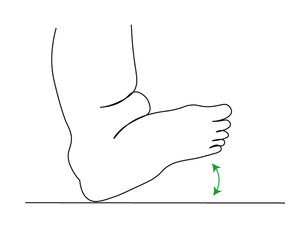Positional defects of the leg
Positional defects of the leg are caused by the position of the limbs during intrauterine development. They manifest as a number of deformities and are usually correctable immediately after birth by passive manipulation (i.e. they can be warmed up and relaxed).
Pes calcaneovalgus[edit | edit source]
Pes calcaneovalgus is the most common congenital malformation of the foot (accounts for 30-50%). It is more common in girls, first-borns and children of young mothers (solid uterine wall).
Clinical picture[edit | edit source]
The opposite of the equinovarous deformity. The leg is placed in the position of maximum dorsiflexion ankle, the back of the leg is sometimes placed on the front part of the lower leg, eversion of the leg. Calcaneus in a valgus position. Deep skin folds are visible above the flexed part of the limb.
Differential diagnosis[edit | edit source]
- Talus verticalis, in contrast to pes calcaneovalgus, is completely rigid, the foot cannot be moved into a plantigrade position.
- Meningomyelocele
- Arthrogryposis
Therapy[edit | edit source]
The prognosis of the disability is very good. The treatment is conservative, it starts already in the maternity ward and consists in repeatedly converting the leg into plantar flexion.
Positional pes valgus[edit | edit source]
- rarer defect
- similar exercises, only redress exercises are opposite
Positional metatarsus adductus[edit | edit source]
- congenital defect of the leg, where the forefoot is adducted against the back of the leg, which is in a normal position
- must be distinguished from the varus position of the metatarsals (rigid, conditioned by subluxation in the Lisfranc joint, requires intensive treatment)
Therapy[edit | edit source]
- again requires only RHB performed as instructed by the mother
Positional pes equinovarus congenitus[edit | edit source]
- hard to distinguish from pes equinovarus congenitus
- congenital defect, kt. responds well to conservative treatment → surgery is not necessary if the treatment is well managed
- however, if the defect is left untreated, contractures will also occur here, kt. they maintain the deformity → necessity of surgery
Links[edit | edit source]
Related Articles[edit | edit source]
- Congenital limb defects
- Arthrogryposis multiplex congenita
- Non-positional leg defects
- Pes equinovarus congenitus
- Metatarsus varus
- Congenital steep talus
References[edit | edit source]
- DUNGL, P., et al. Ortopedie. 1. edition. Prague : Grada Publishing, 2005. ISBN 80-247-0550-8.
- SOSNA, A. – VAVŘÍK, P. – KRBEC, M., et al. Základy ortopedie. 1. edition. Prague : Triton, 2001. ISBN 80-7254-202-8.
- KOUDELA, K., et al. Ortopedie. 1. edition. Prague : Karolinum, 2004. ISBN 80-246-0654-2.

